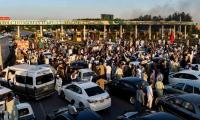According to a new study conducted by the Pakistan Metrological Department, climate in Punjab and Sindh is rising by an average of 0.4 percent per decade. This is coupled with a decline in rainfall, which essentially means hotter, harsher conditions over the agricultural plains in both provinces. If the predictions are accurate, this would mean that by around 2050, or the middle of the current century, we could be confronted by a rise in climate that averages somewhere between 2.5 degrees Celsius and 8.5 degrees, and a fall in rainfall of 30 to 40 percent. These drought-like conditions, which could easily await us in the future, would have an immense impact on two key crops: cotton and wheat, both vital for the economic and humanitarian welfare of the country. Behind this dangerous threat lies climatic change or global warming bringing a change in weather patterns, which poses a risk to the whole world but has been discussed too rarely in Pakistan, where apart from endangering agricultural production it could also speed up glacial melt, increasing the severity of seasonal flooding and the destruction of communities due to landslides and accompanying risks.
The meeting held last week by the Senate Standing Committee on Climate Change on the potential consequences that emerge from the Met office findings is good news, given the limited attention given to the problem in the past. Experts on environment, water management and agriculture, who met at the session called by the Senate committee spoke about altering planting patterns, introducing different varieties of cotton and wheat better able to withstand drought and also managing water usage more effectively as we move towards a situation in which it is becoming an increasingly scarce resource. Certainly, all these measures are badly needed. We also need many more meetings with experts to discuss what is required in terms of experimenting with crop strains, changing the time when seeds are sown and also educating farmers, both big and small, about a problem most understand only very poorly. As the threat draws closer and its scale grows more alarming, Pakistan also needs to become more involved with regional countries in combating a problem which threatens people everywhere. It must indeed take the lead in finding a way forward and warding off what could prove to be one of the biggest crises the world has faced.
Fisherfolk community has long been sidelined, their voices drowned by clamour of more powerful actors
Earlier this month, 27 people were martyred and 40 injured in suicide explosion at Quetta’s railway station
Medical experts estimate that global deaths attributable to AMR could reach 2 million in 2050
G20 leaders met to address global challenges and crises and promote strong, sustainable, and inclusive growth
Day aims to affirm need to eliminate child sexual exploitation, abuse and violence
Chief Minister House Khyber Pakhtunkhwa has become centre of PTI’s political activities







